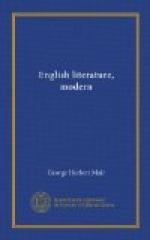Lastly, besides this awakened historical sense, and this quickening of imaginative sensibility to the message of nature, the Romantic revival brought to literature a revival of the sense of the connection between the visible world and another world which is unseen. The supernatural which in all but the crudest of mechanisms had been out of English literature since Macbeth, took hold on the imaginations of authors, and brought with it a new subtlety and a new and nameless horror and fascination. There is nothing in earlier English literature to set beside the strange and terrible indefiniteness of the Ancient Mariner, and though much in this kind has been written since, we have not got far beyond the skill and imagination with which Coleridge and Scott worked on the instinctive fears that lie buried in the human mind.
Of all these aspects of the revival, however, the new sensitiveness and accessibility to the influences of external nature was the most pervasive and the most important. Wordsworth speaks for the love that is in homes where poor men lie, the daily teaching that is in
“Woods and rills;
The silence that is in the starry sky,
The peace that is among the lonely hills.”
Shelley for the wildness of the west wind, and the ubiquitous spiritual emotion which speaks equally in the song of a skylark or a political revolution. Byron for the swing and roar of the sea. Keats for verdurous glooms and winding mossy ways. Scott and Coleridge, though like Byron they are less with nature than with romance, share the same communion.
This imaginative sensibility of the romantics not only deepened their communion with nature, it brought them into a truer relation with what had before been created in literature and art. The romantic revival is the Golden Age of English criticism; all the poets were critics of one sort or another—either formally in essays and prefaces, or in passing and desultory flashes of illumination in their correspondence. Wordsworth, in his prefaces, in his letter to a friend of Burns which contains such a breadth and clarity of wisdom on things that seem alien to his sympathies, even in some of his poems; Coleridge, in his Biographia Literaria, in his notes on Shakespeare, in those rhapsodies at Highgate which were the basis for his recorded table talk; Keats in his letters; Shelley in his Defence of Poetry; Byron in his satires and journals; Scott in those lives of the novelists which contain so much truth and insight into the works of fellow craftsmen—they are all to be found turning the new acuteness of impression which was in the air they breathed, to the study of literature, as well as to the study of nature. Alongside of them were two authors, Lamb and Hazlitt, whose bent was rather critical than creative, and the best part of whose intelligence and sympathy was spent on the sensitive and loving divination of our earlier literature. With these two men began the criticism of acting and of pictorial art that have developed since into two of the main kinds of modern critical writing.




